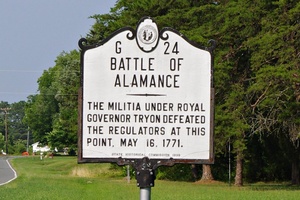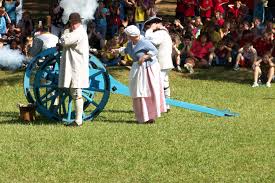Overview
Alamance County began in the 1740's when European Settlers traveled in greater numbers. Alamance County developed from the original settlement, Orange County. The county originally Quaker, was based in the religion's values and beliefs. According to Laurie Smith, Assistant Director at the Historical Museum of Alamance County, Quakers were pacifists. She went on to say that, "typical of Quaker tradition, many mills were established along Cane Creek. They were all farmers and dependent on an agricultural economy." The patriarch of the young community was a Quaker named Simon Dixon. Simon Dixon owned a local mill and was a founder of the Cane Creek Friends Meetings, which were Quaker based community gatherings similar to present day town hall meetings. Colonial Alamance County exists today in an area known as "Snow Camp," North Carolina. Numerous sites of colonial Alamance are marked around the community.
The Quaker Influence
Colonial Alamance County was heavily Quaker. Other religious factions existed such as the Lutherans and Presbyterians, but Quaker sentiment existed throughout the region due largely to Simon Dixon. Simon Dixon was a prominent member in the community who founded the Friends Meetings, which helped instill Quaker values of peace and support for one another in the community. In addition he was also a local business owner that operated a gristmill and was still functioning until the 20th century. Dixon was close with fellow Quaker Nathanael Greene, who, in an ultimate act of self sacrifice for the community, renounced his Quaker spirituality and fought to protect Snow Camp in the Battle of Alamance Park and the Battle of Guiliford Courthouse (he revoked his Quaker religion because he could not fight in battle without doing so). The Quakers used their traditional "Quaker Plan" (that they brought to their new colony from Europe) to set up an efficient crop rotation cycle and establish factories to better the community.
The Regulators Movement
The Regulators Movement was a rebellion by the poor farmers of NC in response to corrupt tax collection by the Sheriff's Office. Sherrif's Offices were tasked with enforcing higher taxes due to NC militia aiding Great Britain in a 1750 war with France. The unfair collection of taxes coupled with North Carolinian and Snow Camp soldiers not being compensated for their service sparked the movement. The Regulators carried out enough small attacks and skirmishes throughout the countryside in 1771 to the point that a response had to be made by the colonial militia. Lead by Governor Tryon, the colonial armed crushed the rebellion in the decisive conflict known today as The Battle of Alamance.
Battles
- The Battle of Alamance
The Battle of Alamance was the decisive battle between The Regulators and the colonial militia. The start of the battle is still a matter of debate. It is unanimously recognized and agreed upon the ultimate reasons for the battle were motives of The Regulators, however, stories conflict as to how exactly the battle began. One story claims that Governor Tryon, the head of the colonial militia's forces, was visited in his camp by Robert Thompson, a Regulator. Tryon was supposedly insulted by Thompson who listed off a series of Regulator demands and then turned his back and walked from the camp. Tryon felt so disrespected by this action that he shot Thompson in the back as he was walking away. Regardless of the precision of the story of how the battle began, the facts of the battle itself are concrete. On the bank of the Haw River, 6,000 Regulators squared off against 2,000 colonial militia. Despite their numerical advantage, The Regulators were crushed due to a significant technological disadvantage. The ultimate legacy of the battle existed in the fighting tactics used by the rebels, whose style would soon be modeled by the colonial army in the Revolutionary battles against the British.
- The Battle of Guilford Courthouse
A series of slaughters and rebellions occurred throughout North Carolina following the Battle of Alamance County due to growing revolutionary fervor. The conflicts came to a head in Alamance county in 1781 with the Battle of Guilford Courthouse. The battle posed General Charles Cornwallis of Britain against General Nathaneal Greene from the city now named after him, Greensboro. Greene had just been appointed by George Washington to lead the colonial effort in the South where more battles were starting to occur after the majority had been taking place in the North. Following the Battle of Cowpens, Cornwallis turned his attention towards the forces of General Greene, and on March 15, 1781 the conflict took place outside Guilford Courthouse. The battle took place over the period of a few hours and resulted in a tactical defeat for Greene's forces. However, his army killed nearly 25% of Cornwallis's men, thereby severely depleting British resources. The battle forced Cornwallis to turn his attention toward Virginia where he ultimately failed and was forced to surrender to Washington at Yorktown. According to Laurie Smith, the battle is noted by some for the origin of the phrase, "wining the battle, but losing the war".
Present Day Reminisce of Colonial Alamance County
Alamance County has made a commendable effort to preserve it's history even as far back as the colonial period. While certain aspects of Alamance's colonial history are more local, other aspects have greater implications. An example of this is the Battle of Guilford Courthouse which proved to be decisive in the Revolutionary War. Today, The Snow Camp Outdoor Theater is maintained by the County. Annual performances are held in memory of colonial history one of which stars Simon Dixon and his leadership in the original colony. The play is called, "The Sword of Peace" and is based loosely on actual events. Furthermore, annual battle reenactments take place in the county. The Battle of Alamance is the most notable battle reenacted in the area. The Historical Museum of Alamance County and the Historical Society also do a marvelous job of memorializing and remembering the colonial period. Their efforts have preserved the oldest surviving house of the county (1780) and moved it to the site of the Battle of Alamance.
Sources
Alamance County, North Carolina - Wikipedia, the free encyclopedia. (2013, October 4). Wikipedia, the free encyclopedia. Retrieved October 8, 2013, from http://en.wikipedia.org/wiki/Alamance_Coun
Battle of Guilford Courthouse. (2013). The History Channel website. Retrieved 4:25, October 8, 2013, from http://www.history.com/topics/battle-of-guilford-courthouse.
NC Historic Sites - Alamance Battleground. (n.d.). NC Historic Sites. Retrieved October 8, 2013, from http://www.nchistoricsites.org/alamance/
Reenactments - Events in Alamance County, North Carolina. (n.d.). Welcome to LASR !!. Retrieved October 8, 2013, from http://www.lasr.net/travel/county.php?Alamance+County+Reenactments&EventCategory=Reenactments&VE=Y&TravelTo=NC0301#.UlRoGtKsgyq
Snow Camp Outdoor Theater - Wikipedia, the free encyclopedia. (2013, March 22). Wikipedia, the free encyclopedia. Retrieved October 8, 2013, from http://en.wikipedia.org/wiki/Snow_Camp_Outdoor_Theater
The Colonial Period - Alamance County. (n.d.). Alamance County Home - Alamance County. Retrieved October 8, 2013, from http://www.alamance-nc.com/about-alamance-county/history/the-colonial-period.html
Vacca, M., & Briggs, B. (n.d.). History of Alamance County 1670-1945. Report. Retrieved October 8, 2013, from http://www.hpo.ncdcr.gov/surveyreports/A




